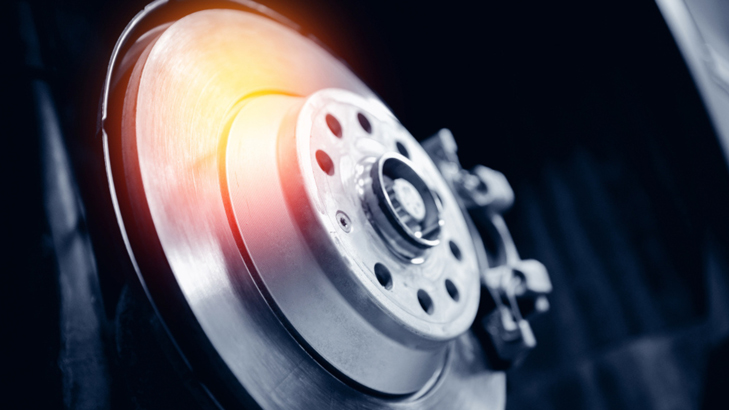Few things are as vital to your safety on the road as your car’s brakes. Maintaining them not only ensures a smooth driving experience but also plays a critical role in preventing accidents. Knowing when to maintain and replace your brakes is key to keeping your vehicle in top condition and yourself out of harm’s way.
Maintaining your brakes involves several key steps that collectively ensure their optimal performance and longevity. Here’s a more detailed expansion on brake maintenance
1. Check for Warning Signs
- Screeching, Grinding Noises, Vibrations, or Soft Brake Pedal: These are crucial indicators that warrant immediate attention. High-pitched sounds while braking often signify worn-out brake pads. Ignoring these signs can lead to more extensive damage and compromise safety.
2. Inspect Brake Pads
- Regular Thickness Checks: Periodically inspect your brake pads for wear. Most manufacturers recommend replacing pads when they’re approximately 1/8 inch thick. Utilise a flashlight to peer through the wheel spokes and visually check the pad thickness. If the pads seem excessively worn, it’s time for a replacement.
3. Fluid Checks
- Brake Fluid Level and Quality: Brake fluid is vital for transferring force within the braking system. Regularly check the brake fluid reservoir under the hood and ensure it’s at the recommended level. Additionally, examine the fluid’s colour; it should be transparent or slightly yellow. Contaminated or dark-coloured fluid may indicate the need for a flush and replacement.
4. Rotor Inspection
- Look for Grooves or Scoring: The condition of the rotors significantly impacts braking efficiency. Inspect the rotors for any grooves, scoring, or visible damage. These issues can hinder proper braking and might require resurfacing or replacement to maintain optimal performance.
5. Regular Servicing
- Scheduled Professional Inspections: Regularly scheduling check-ups with a certified mechanic is crucial. They have the expertise to conduct thorough brake system inspections. Professional mechanics can identify potential issues early on, perform necessary adjustments, and ensure your brakes are in top condition.
Additional Tips for Brake Maintenance
- Brake Pad Replacement: When replacing brake pads, it’s advisable to change all pads on the same axle for balanced braking performance.
- Caliper Inspection: Check the brake callipers for proper operation and signs of leakage. Faulty callipers can lead to uneven braking and should be addressed promptly.
- Brake System Bleeding: Consider having your brake system bled periodically to remove air bubbles that might accumulate, affecting brake performance.
- Driving Habits: Avoid sudden or aggressive braking whenever possible. Gradual, smoother braking extends the life of brake components.
Regular maintenance of your brakes not only ensures your safety but also prevents costly repairs in the long run. Being attentive to warning signs and conducting routine checks can significantly contribute to the overall health and performance of your vehicle’s braking system.
Remember, if you’re ever uncertain about your car’s brake condition or notice any irregularities, it’s best to consult a professional mechanic for a thorough inspection and necessary repairs.
Recognising when it’s time to replace your brakes is crucial for maintaining safety and optimal performance. Here’s a more comprehensive expansion on the signs indicating the need for brake replacement:
1. Screeching or Grinding Noises:
- Worn-out Brake Pads: High-pitched screeching or grinding sounds when applying the brakes often indicate worn-out brake pads. As the friction material on the pads wears down, a metal-on-metal contact occurs, leading to these sounds. Ignoring this can not only damage the rotors but also compromise braking efficiency and safety.
2. Vibrations or Pulsations:
- Warped Rotors: When you feel vibrations or pulsations while braking, it might signify warped rotors. Warping can occur due to excessive heat buildup or uneven wear and tear. This issue demands immediate attention as it affects the smoothness and effectiveness of braking, potentially compromising safety.
3. Soft Brake Pedal:
- Air or Moisture in Brake Lines or Worn-out Brake Pads: A spongy or soft brake pedal could indicate air or moisture in the brake lines, causing an inefficient transfer of force when braking. It could also suggest excessively worn brake pads that are no longer able to generate enough friction to stop the vehicle promptly. Addressing this issue promptly is essential for safe braking.
4. Brake Warning Light:
- Sensor Detection of Brake Wear: Modern vehicles come equipped with sensors that detect brake wear. If the brake warning light illuminates on your dashboard, it’s a clear signal that the brake pads have reached a critically low thickness and require immediate inspection and possible replacement. Ignoring this warning can lead to severe damage to other brake components.
5. Visual Inspection:
- Excessively Worn Brake Pads or Scored Rotors: Conducting a visual inspection of the brake pads and rotors can provide tangible evidence of wear. Excessively worn brake pads, usually less than 1/8 inch thick, or visible scoring and damage on the rotors indicate that it’s time for a replacement. Ignoring these visible signs can lead to decreased braking performance and potential safety hazards.
Additional Indicators for Brake Replacement
- Uneven Braking: If your car pulls to one side when braking, it could indicate uneven brake pad wear or a sticking calliper, requiring attention.
- Burning Smell: A burning odour after braking might signify overheated brakes, possibly due to worn-out pads or sticking callipers.
- Reduced Braking Performance: Any noticeable decrease in braking efficiency or longer stopping distances warrants immediate inspection and potential replacement of brake components.
Recognising these signs and taking proactive steps to address brake issues promptly is essential for your safety and the longevity of your vehicle’s braking system. Always prioritise regular inspections and heed warning signs to ensure your brakes are in optimal condition. If you notice any of these signs, it’s advisable to consult a professional mechanic for a thorough inspection and necessary replacements.
